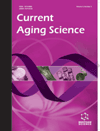- Home
- A-Z Publications
- Current Aging Science
- Previous Issues
- Volume 3, Issue 2, 2010
Current Aging Science - Volume 3, Issue 2, 2010
Volume 3, Issue 2, 2010
-
-
Evidence for the Involvement of Lamins in Aging
More LessAuthors: Sofia Rodriguez and Maria ErikssonThe molecular mechanisms that cause physiological aging are still not completely understood, most likely because of the complex nature of the aging process. Recent discoveries on segmental progeroid syndromes emphasize the importance of studying rare diseases to discover more common mechanisms. Since the identification of mutations in the LMNA gene that causes the segmental progeroid syndrome, Hutchins Read More
-
-
-
Molecular Mechanisms in Aging and Current Strategies to Counteract Sarcopenia
More LessAuthors: Kunihiro Sakuma and Akihiko YamaguchiSarcopenia, the progressive loss of muscle mass with age, is characterized by a deterioration of muscle quantity and quality leading to a gradual slowing of movement and a decline in strength and power. Sarcopenia is a highly significant public health problem. Since these age-related changes in skeletal muscle are largely attributed to various molecular mediators affecting fiber size, mitochondrial homeostatis, and apo Read More
-
-
-
Uncoupling Protein-2 and the Potential Link Between Metabolism and Longevity
More LessThe discovery of novel uncoupling proteins (UCP2 and UCP3) over 10 years ago heralded a new era of research in mitochondrial uncoupling in a diverse range of tissues. Despite the research vigor, debate stills surrounds the exact function of these uncoupling proteins. For example, the level of uncoupling, the mechanism and mode of action are all under-appreciated at this point in time. Our recent work has used genetic mou Read More
-
-
-
Effects of Estrogen in the Brain: Is it a Neuroprotective Agent in Alzheimer's Disease?
More LessOver the last decades estrogen has been recognized to be involved in normal brain function due to its neurothrophic and neuroprotective effects. Estrogen is intimately associated with neuronal survival, mitochondrial function, neuroinflammation and cognition through genomic as well as non-genomic pathways. It is also known that the neuroprotective actions mediated by estrogens are interlinked with the insulin-like growth fa Read More
-
-
-
Effects of ε4 on Object Recognition in the Non-Demented Elderly
More LessAuthors: Gwendolen E. Haley, Frederique Berteau-Pavy, Byung Park and Jacob RaberPreviously we reported that Apolipoprotein E (ApoE) ε4 negatively affects performance in the novel-image-novel- location (NINL) object recognition test in healthy non-demented elderly human study participants. In this study, the participants were invited to return for testing sessions 6 and 18 months after the baseline session. Using a longitudinal study design, effects of ε4 on NINL test performance were assessed in study “dro Read More
-
-
-
The Six Item Cognitive Impairment Test (6-CIT) as a Screening Test for Dementia: Comparison with Mini-Mental State Examination (MMSE)
More LessAuthors: Ajaya K. Upadhyaya, Magesh Rajagopal and Tim M. GaleBackground: The UK national Dementia Strategy clearly outlines a case for early detection and diagnosis of dementia. There is thus a need for a brief screening test for dementia in primary care, which can be administered and scored easily. Aim: To compare the performance of two cognitive scales, Mini-Mental State Examination (MMSE) and 6 Item Cognitive Impairment Test (6-CIT), as screening test for dementia in a naturali Read More
-
-
-
Accessing Timely Rehabilitation Services for a Global Aging Society? Exploring the Realities within Canada's Universal Health Care System
More LessAuthors: Michel D. Landry, Sudha R. Raman and Elham HamdanThe proportion of older persons is increasing in developed and developing countries: this aging trend can be viewed as a two-edged sword. On the one hand, it represents remarkable successes regarding advances in health care; and on the other hand, it represents a considerable challenge for health systems to meet growing demand. A growing disequilibrium between supply and demand may be particularly challenging within p Read More
-
-
-
Hospital Utilization and Aging in Spain (2006)
More LessAuthors: Emilio Moreno-Millan, Agustin Molina-Morales and Ignacio Amate-FortesObjectives: The main objective of this study is to verify the existence of a direct relation between age, ageing and hospital resources utilization. Methods: For this purpose, we use not only population variables, but also clinical parameters such as severity and complexity, as proxy of consumption and hospital costs. Through a comprehensive statistical analysis, quantitative variables of the Spanish Minimum Data Set o Read More
-
Volumes & issues
Most Read This Month
Article
content/journals/cas
Journal
10
5
false
en

Most Cited Most Cited RSS feed
-
-
Polyphenols and Aging
Authors: Brannon L. Queen and Trygve O. Tollefsbol
-
- More Less

